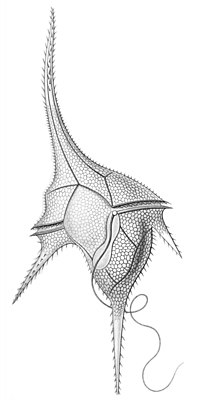
Photo from wikipedia
The dinoflagellates Amphidinium carterae and Amphidinium corpulentum have been previously characterized as having Δ8(14)‐nuclear unsaturated 4α‐methyl‐5α‐cholest‐8(14)‐en‐3β‐ol (C28:1) and 4α‐methyl‐5α‐ergosta‐8(14),24(28)‐dien‐3β‐ol (amphisterol; C29:2) as predominant sterols, where they comprise approximately 80% of… Click to show full abstract
The dinoflagellates Amphidinium carterae and Amphidinium corpulentum have been previously characterized as having Δ8(14)‐nuclear unsaturated 4α‐methyl‐5α‐cholest‐8(14)‐en‐3β‐ol (C28:1) and 4α‐methyl‐5α‐ergosta‐8(14),24(28)‐dien‐3β‐ol (amphisterol; C29:2) as predominant sterols, where they comprise approximately 80% of the total sterol composition. These two sterols have hence been considered as possible major sterol biomarkers for the genus. Here, we have examined the sterols of four recently identified species of Amphidinium (Amphidinium fijiense, Amphidinium magnum, Amphidinium theodori, and Amphidinium tomasii) that are closely related to Amphidinium operculatum as part of what is termed the Operculatum Clade to show that each species has its sterol composition dominated by the common dinoflagellate sterol cholesterol (cholest‐5‐en‐3β‐ol; C27:1), which is found in many other dinoflagellate genera, rather than Δ8(14) sterols. While the Δ8(14) sterols 4α‐methyl‐5α‐cholest‐8(14)‐en‐3β‐ol and 4α,23,24‐trimethyl‐5α‐cholest‐8(14),22E‐dien‐3β‐ol (C30:2) were present as minor sterols along with another common dinoflagellate sterol, 4α,23,24‐trimethyl‐5α‐cholest‐22E‐en‐3β‐ol (dinosterol; C30:1), in some of these four species, amphisterol was not conclusively observed. From a chemotaxonomic perspective, while this does reinforce the genus Amphidinium's ability to produce Δ8(14) sterols, albeit here as minor sterols, these results demonstrate that caution should be used when considering Δ8(14) sterols, especially amphisterol, as Amphidinium‐specific biomarkers within these species where cholesterol is the predominant sterol.
Journal Title: Journal of Eukaryotic Microbiology
Year Published: 2022
Link to full text (if available)
Share on Social Media: Sign Up to like & get
recommendations!